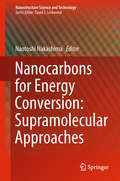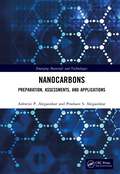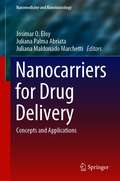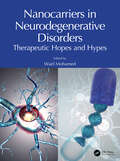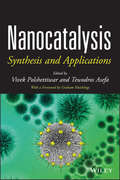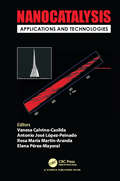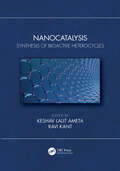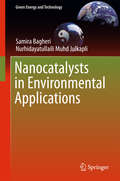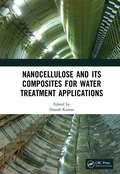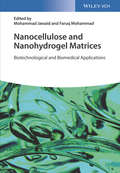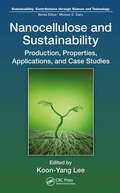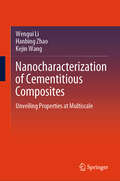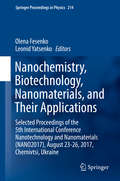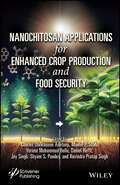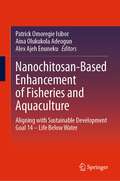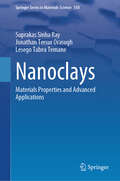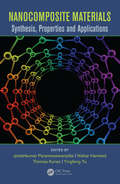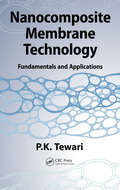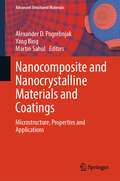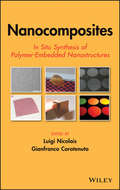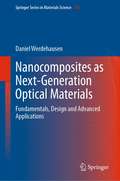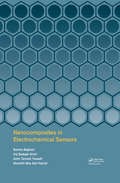- Table View
- List View
Nanocarbons for Energy Conversion: Supramolecular Approaches (Nanostructure Science and Technology)
by Naotoshi NakashimaThis book focuses on nanocarbons (carbon nanotubes, graphene, nanoporous carbon, and carbon black) and related materials for energy conversion, including fuel cells (predominately proton exchange membrane fuel cells [PEMFC]), Li-ion batteries, and supercapacitors. Written by a group of internationally recognized researchers, it offers an in-depth review of the structure, properties, and functions of nanocarbons, and summarizes recent advances in the design, fabrication and characterization of nanocarbon-based catalysts for energy applications. As such, it is an invaluable resource for graduate students, academics and industrial scientists interested in the areas of nanocarbons, energy materials for fuel cells, batteries and supercapacitors as well as materials design, and supramolecular science.
Nanocarbons: Preparation, Assessments, and Applications (Emerging Materials and Technologies)
by Ashwini P. Alegaonkar Prashant S. AlegaonkarThis book provides a practical platform to the readers for facile preparation of various forms of carbon in its nano-format, investigates their structure–property relationship, and finally, realizes them for a variety of applications taking the route of application engineering. It covers the preparation and evaluation of nanocarbons, variety of carbon nanotubes, graphene, graphite, additively manufactured 3D carbon fibres, their properties, and various factors associated with them. A summary and outlook of the nanocarbon field is included in the appendices. Features: Presents comprehensive information on nanocarbon synthesis and properties and some specific applications Covers the growth of carbon nanoparticles, nanotubes, ribbons, graphene, graphene derivatives, porous/spongy phases, graphite, and 3D carbon fabrics Documents a large variety of characterizations and evaluations on the nature of growth causing effect on structure properties Contains dedicated chapters on miniaturized, flat, and 2D devices Discusses a variety of applications from military to public domains, including prevalent topics related to carbon. This book is aimed at researchers and graduate students in materials science and materials engineering, and physics.
Nanocarrier Vaccines: Biopharmaceutics-Based Fast Track Development
by Vasso Apostolopoulos Vivek P. ChavdaNANOCARRIER VACCINES This book details the benefits, restrictions, and types of nanoparticles used in the creation of vaccines for the treatment and prevention of illnesses. In nanomedicine and nano-delivery systems, materials in the nanoscale range are used as diagnostic instruments or to administer therapeutic compounds to particular targeted regions in a controlled manner. By delivering precise medications to specified locations and targets, nanotechnology provides several advantages in treating chronic human illnesses. The use of nanomedicine (including chemotherapeutic medicines, biological agents, immunotherapeutic agents, etc.) in the treatment of various diseases has recently seen many notable applications. This book aims to be a single source material for understanding all the current and novel advancements in the field of nanotechnology. In this groundbreaking book the reader will find: biodegradable and non-biodegradable formulations and properties such as size, shape, charge, inertness, efficacy, morphology, and more; show how different nanoparticles, such as lipid-based, viral vector-based, and metal, uphold very significant properties individually, suggesting applicability in various management tactics; examines how genetic information-carrying entities are becoming the norm for eradicating some diseases; gathers an exhaustive amount of information on routes of administration such as the oral route, mucosal immunity, intramuscular, subcutaneous, and intradermal; explores the legal regulations for nanotechnology-based approaches. Audience Researchers and pharmacy students in biomedical engineering and chemical engineering, biotechnology, as well as pharmaceutical and biopharmaceutical industry engineers working in drug discovery, chemical biology, computational chemistry, medicinal chemistry, and bioinformatics.
Nanocarriers for Controlled Release and Target Delivery of Bioactive Compounds (SpringerBriefs in Food, Health, and Nutrition)
by Brijesh K. Tiwari Colm P. O'Donnell Shivani Pathania Shaba Noore Pablo FuciñosThis brief provides a comprehensive overview of nanocarriers used for nanoencapsulation of bioactive compounds. It includes the basis of encapsulation mechanism, encapsulation efficiency, controlled release, target delivery, and its application in food, nutraceuticals, pharmaceuticals and cosmeceuticals.
Nanocarriers for Drug Delivery: Concepts and Applications (Nanomedicine and Nanotoxicology)
by Josimar O. Eloy Juliana Palma Abriata Juliana Maldonado MarchettiThis book covers basic aspects of different nanoparticles, including type of materials, lipid, polymeric and inorganic structures, synthesis strategies, as well as the main physicochemical characterization techniques. Moreover, this book addresses applications for both treatment and diagnosis of diseases, highlighting in vitro and in vivo findings and clinical evaluation. The chapters highlight the main barriers for drug delivery which can benefit from nanoencapsulation: the topical and oral routes. The main innovations in the field, such as gene therapy and functionalization of nanoparticles with a variety of moieties, including monoclonal antibodies for selective delivery, are discussed and illustrated with examples. Finally, the application of nanoparticles for drug delivery to cancer is reviewed considering toxicology and regulatory aspects.
Nanocarriers in Neurodegenerative Disorders: Therapeutic Hopes and Hypes
by Wael MohamedDue to the lack of secure, efficient, and patient-friendly therapies for neurodegenerative disorders, there is a rising demand for innovative approaches. Despite the limited number of nanocarriers approved for human use, they have demonstrated significant potential in preclinical and, in some instances, clinical trials. In alignment with this objective, the chapters of the book are structured to offer a comprehensive overview of recent advancements in medication and dosage form development, specifically emphasizing the nanoparticulate system for targeting the brain. This book aims to furnish readers with a thorough understanding of the clinical application of nanocarrier systems for treating neurodegenerative disorders, encompassing the latest developments, challenges, safety concerns, toxicity issues, regulatory considerations, prospects, and limitations. Individuals in academia, the scientific community, business, and education seeking a more effective approach to target the brain will find valuable insights in this resource.Key Features Provides a comparative perspective of various nanocarrier systems, therefore facilitating the researcher's selection of appropriate nanoparticulate carriers Highlights the related restrictions of brain delivery and current available medicines Includes information on the advantages and disadvantages of various biomaterials utilized in the development of nanocarriers for brain targeting Emphasizes distinct facets of surface functionalization according to the brain area of interest Presents the current advances, preclinical and clinical development, and the future potential of multiple brain-targeting technologies
Nanocarriers: An Evidence Based Approach
by Nirmal ShahA suitable drug delivery system is an essential element in achieving efficient therapeutic responses of drug molecules. With this desirability in mind, the book unites different techniques through which extremely small-sized particles can be utilized as a successful carrier for curing chronic as well as life-threatening diseased conditions. This is a highly informative and prudently organized book, providing scientific insight for readers with an interest in nanotechnology. Beginning with an overview of nanocarriers, the book impetuses on to explore other essential ways through which these carriers can be employed for drug delivery to varieties of administrative routes. This book discusses the functional and significant features of nanotechnology in terms of Lymphatic and other drug targeting deliveries. The book is presenting depth acquaintance for various vesicular and particulate nano-drug delivery carriers, utilized successfully in Pharmaceutical as well as in Cosmeceutical industries along with brief information on their related toxicities. In addition, the work also explores the potential applications of nanocarriers in biotechnology sciences for the prompt and safe delivery of nucleic acid, protein, and peptide-based drugs. An exclusive section in the book illuminates the prominence and competent applicability of nanotechnology in the treatment of oral cancer. The persistence of this book is to provide basic to advanced information for different novel carriers which are under scale-up consideration for the extensive commercialization. The book also includes recent discoveries and the latest patents of such nanocarriers. The cutting-edge evidence of these nanocarriers available in this book is beneficial to students, research scholars, and fellows for promoting their advanced research.
Nanocatalysis
by Vivek Polshettiwar Tewodros Asefa Graham HutchingsExhibiting both homogeneous and heterogeneous catalytic properties, nanocatalysts allow for rapid and selective chemical transformations, with the benefits of excellent product yield and ease of catalyst separation and recovery. This book reviews the catalytic performance and the synthesis and characterization of nanocatalysts, examining the current state of the art and pointing the way towards new avenues of research. Moreover, the authors discuss new and emerging applications of nanocatalysts and nanocatalysis, from pharmaceuticals to fine chemicals to renewable energy to biotransformations.Nanocatalysis features contributions from leading research groups around the world. These contributions reflect a thorough review of the current literature as well as the authors' first-hand experience designing and synthesizing nanocatalysts and developing new applications for them. The book's nineteen chapters offer a broad perspective, covering:Nanocatalysis for carbon-carbon and carbon-heteroatom coupling reactionsNanocatalysis for various organic transformations in fine chemical synthesisNanocatalysis for oxidation, hydrogenation, and other related reactionsNanomaterial-based photocatalysis and biocatalysisNanocatalysts to produce non-conventional energy such as hydrogen and biofuelsNanocatalysts and nano-biocatalysts in the chemical industryReaders will also learn about the latest spectroscopic and microscopy tools used in advanced characterization methods that shed new light on nanocatalysts and nanocatalysis. Moreover, the authors offer expert advice to help readers develop strategies to improve catalytic performance.Summarizing and reviewing all the most important advances in nanocatalysis over the last two decades, this book explains the many advantages of nanocatalysts over conventional homogeneous and heterogeneous catalysts, providing the information and guidance needed for designing green, sustainable catalytic processes.
Nanocatalysis: Applications and Technologies
by Vanesa Calvino-Casilda Antonio José López-Peinado Rosa María Martín-Aranda Elena Pérez MayoralSynthesis and design of new nanocatalysts is an important area of research that aims to introduce multiple types of useful applications in a greener market. The necessity of nanostructuring the active sites has emerged as the key point in a successful design of the catalysts. The book covers the progress in this research area done in the last ten years. It includes the classification of catalysts and structure of active sites at the nanoscale. The book covers examples to present the concept, evolution of nanocatalysts from the perspective of chemistry of materials and their applications.
Nanocatalysis: Synthesis of Bioactive Heterocycles
by Keshav Lalit AmetaThe field of nanocatalysis is undergoing rapid development. Nanocatalysis can help in designing catalysts with excellent activity, greater selectivity, and high stability. Their properties can easily be tuned by tailoring the size, shape, and morphology of the particular nanomaterial. Exhibiting both homogeneous and heterogeneous catalytic properties, nanocatalysts allow for rapid and selective chemical transformations, with the benefits of excellent product yield and ease of catalyst separation and recovery. Nanocatalysis: Synthesis of Bioactive Heterocycles reviews the catalytic performance and the synthesis and characterization of nanocatalysts, examining the current state of the art and pointing the way towards new avenues of research specially synthesis of bioactive heterocycles. Top researchers summarize synthetic methodologies for the synthesis of bioactive heterocycles using a nanocatalytic framework. The catalytic performance and the synthesis and characterization of nanocatalysts are reviewed. State of the art methods and new and emerging applications of nanocatalysts in the synthesis of biologically active heterocycles are detailed. Additional features include: Focuses on designing and synthesizing nanocatalysts specifically for the synthesis of different bioactive heterocycles. Demonstrates how nanocatalysis can produce catalysts with excellent activity, greater selectivity, and high stability. Explores tuning catalysts properties by tailoring the size, shape, and morphology of a nanomaterial. Offers the reader insights into the field of nanoscience via nanocatalysis. Nanocatalysis: Synthesis of Bioactive Heterocycles is a must read for researchers in organic chemistry, medicinal chemistry and biochemistry.
Nanocatalysts in Environmental Applications (Green Energy and Technology)
by Samira Bagheri Nurhidayatullaili Muhd JulkapliThis book presents a range of nanocatalysts, together with their primary environmental applications and use in chemical production processes. In addition, it describes the nanomaterials used for catalysts and details their performance.The book introduces readers to the fundamentals and applications of nanocatalysis, synthesis, characterization, modification and application. Further topics include: landfill organic pollutant photodegradation; magnetic photocatalysis; synergistic effects on hydrogenated TiO2; and photoinduced fusion of gold-semiconductor nanoparticles.A detailed explanation of the chemistry of nanostructures and the ability to control materials at the nano-scale rounds out the coverage. Given the central importance of research in nanotechnology and nanoscience for the development of new catalysts, the book offers a valuable source of information for researchers and academics alike. It will also benefit industrial engineers and production managers who wish to understand the environmental impact of nanocatalysts.
Nanocellulose and Its Composites for Water Treatment Applications
by Dinesh KumarBiological materials and their applications have drawn increasing attention among scientists. Cellulose is an abundant, renewable, biodegradable, economical, thermally stable, and light material, and it has found application in pharmaceuticals, coatings, food, textiles, laminates, sensors, actuators, flexible electronics, and flexible displays. Its nano form has extraordinary surface properties, such as higher surface area than cellulose; hence, nanocellulose can be used as a substitute for cellulose. Among many other sustainable, functional nanomaterials, nanocellulose is attracting growing interest in environmental remediation technologies because of its many unique properties and functionalities. Nanocellulose and Its Composites for Water Treatment Applications supplies insight into the application of nanocellulose and its nanocomposites for water purification and remediation. It covers different classes of nanocellulose—cellulose nanocrystal (CNC), microfibrillated cellulose (MFC), hairy cellulose nanocrystalloid (HCNC), and bacterial nanocellulose (BNC)—for their competency with other renewable and carbonaceous materials such as pectin, alginate, and CNTs. Future perspectives of nanocellulose and nanocomposites gleaned from different biodegradable origins are also discussed. This book delves into an updated description of the basic principles and developments in synthesis, characterization methods, properties (chemical, thermal, optical, structural, surface, and mechanical structure), property relationships, crystallization behavior, and degradability of biodegradable nanocomposites. The book also supplies vivid information about various cellulose nanomaterials and their applications in absorbing organic and inorganic toxins, membrane filtration of bacteria, viruses, and ionic impurities, photocatalytic dye removal, and sensing of water toxins. Features Details the synthesis and characterization methods of nanocellulose Illustrates the applications of nanocellulose and its nanocomposites Shows in-depth accounts of the various types of properties of nanocellulose and its composites Features emerging trends in the use of nanocellulose as adsorbents, sensors, membranes, and photocatalysis materials This book will be useful for academics, researchers, and engineers working in water treatment and purification.
Nanocellulose and Nanohydrogel Matrices: Biotechnological and Biomedical Applications
by Mohammad Jawaid Faruq MohammadThis first book on nanocellulose and nanohydrogels for biomedical applications is unique in discussing recent advancements in the field, resulting in a comprehensive, well-structured overview of nanocellulose and nanohydrogel materials based nanocomposites. The book covers different types of nanocellulose materials and their recent developments in the drug delivery and nanomedicine sector, along with synthesis, characterization, as well as applications in the biotechnological and biomedical fields. The book also covers the current status and future perspectives of bacterial cellulose and polyester hydrogel matrices, their preparation, characterization, and tissue engineering applications of water soluble hydrogel matrices obtained from biodegradable sources. In addition, the chitosan-based hydrogel and nanogel matrices, their involvement in the current biofabrication technologies, and influencing factors towards the biomedical sector of biosensors, biopharmaceuticals, tissue engineering appliances, implant materials, diagnostic probes and surgical aids are very well documented. Further, the history of cellulose-based and conducting polymer-based nanohydrogels, their classification, synthesis methods and applicability to different sectors, the challenges associated with their use, recent advances on the inhibitors of apoptosis proteins are also included. The recent developments and applications in the drug delivery sector gives an overview of facts about the nanofibrillated cellulose and copoly(amino acid) hydrogel matrices in the biotechnology and biomedicine field. This book serves as an essential reference for researchers and academics in chemistry, pharmacy, microbiology, materials science and biomedical engineering.
Nanocellulose and Sustainability: Production, Properties, Applications, and Case Studies (Sustainability: Contributions through Science and Technology)
by Koon-Yang LeeNanometre scale cellulose fibres, or nanocellulose, are emerging materials for various advanced applications. Nanocellulose and Sustainability: Production, Properties, Applications, and Case Studies provides a comprehensive overview of nanocellulose production, nanocellulose properties and nanocellulose in selected applications. This book serves as an entry level reference text for undergraduates, graduate students, researchers and professional engineers working in the area of nanocellulose and sustainability. Features: Summarises the surface and bulk properties of various types of nanocellulose Reviews the application of nanocellulose in water purification and optically transparent materials Provides an overview of nanocellulose as Pickering emulsifier, binder for loose natural fibres to produce non-woven preforms, as well as nanocellulose-based aerogels Presents a techno-economic analysis of industrial bacterial cellulose production Discusses the pilot scale production of cellulose nanocrystals
Nanocharacterization of Cementitious Composites: Unveiling Properties at Multiscale
by Wengui Li Hanbing Zhao Kejin WangThis book offers a systemic introduction and summarization of nanoscale characterization techniques on cementitious materials. Cementitious composites are ubiquitous in the realm of construction, serving as the backbone of infrastructure worldwide. These materials, typically composed of cement, aggregates, and water, exhibit a complex interplay of mechanical, chemical, and physical properties. In the introductory chapter, we delve into the fundamental aspects of cementitious composites, exploring their composition, structure, and significance in the construction industry. In the second chapter, we introduced the advancements and applications of nano-characterization techniques for cementitious materials including nanoindentation, nanoscratch, modulus mapping, atomic force microscopy-based nanomechanical mapping techniques. Therefore, in the third chapter, the cementitious materials sample surface processing procedure was introduced. In the fourth chapter, nanoindentation, modulus mapping and PeakForce quantitative nanomechanical mapping (PeakForce QNM) test results were comparatively analysed. In chapter five and six, the nanoscale mechanical properties of sodium aluminosilicate hydrate (N-A-S-H) gel in geopolymer paste with and without nanoparticles was evaluated by grid nanoindentation tests. The nano/micromechanical properties of interfacial transition zones in ordinary concrete, recycled aggregate concrete and geopolymer concrete were investigated in chapter seven, eight and nine. Modelled aggregate samples were used to improve efficiency and reduce unnecessary workload in the microscopic characterization. Finally, challenges and future directions were discussed in chapter ten from cementitious sample surface preparation methods, microscopic characterization method for cementitious materials and testing strategies for complicated interfacial transition zones.
Nanochemistry, Biotechnology, Nanomaterials, and Their Applications: Selected Proceedings of the 5th International Conference Nanotechnology and Nanomaterials (NANO2017), August 23-26, 2017, Chernivtsi, Ukraine (Springer Proceedings in Physics #214)
by Leonid Yatsenko Olena FesenkoThis book presents some of the latest achievements in nanotechnology and nanomaterials from leading researchers in Ukraine, Europe, and beyond. It features selected peer-reviewed contributions from participants in the 5th International Science and Practice Conference Nanotechnology and Nanomaterials (NANO2017) held in Chernivtsi, Ukraine on August 23-26, 2017. The International Conference was organized jointly by the Institute of Physics of the National Academy of Sciences of Ukraine, Ivan Franko National University of Lviv (Ukraine), University of Tartu (Estonia), University of Turin (Italy), and Pierre and Marie Curie University (France). Internationally recognized experts from a wide range of universities and research institutions share their knowledge and key results on topics ranging from energy storage to biomedical applications. This book's companion volume also addresses nanooptics, nanoplasmonics, and interface studies.
Nanochitosan Applications for Enhanced Crop Production and Food Security
by Shyam S. Pandey Maulin P. Shah Charles Oluwaseun Adetunji Ravindra Pratap Singh Jay Singh Daniel Hefft Yerima Mohammed BelloThis unique, important, and timely book provides detailed information about the application of nanochitosan to increase agricultural productivity to enhance food security and nutrition. Readers will find in Nanochitosan Applications for Enhanced Crop Production and Food Security detailed state-of-the-art information including: The modes of action through which nanochitosan perform numerous biological activities; State-of-the-art information and recent advancements in the application of nanochitosan, including targeted delivery, genetic manipulation, antimicrobial uses, curing infections in plants, controlled delivery of biologically active constituents, applications in the evaluation of carbon dioxide concentrations and humidity in controlled greenhouse environments, and their use as pressure sensors in agrichemical spraying equipment; Information on applying nanochitosan as a biofertilizer and bioinsecticide when applied on seeds and for foliar spraying of agricultural crops, soil amendment, and protection against pathogens and pests; The application of nanochitosan in the manufacturing of nanosensors in precision farming in the determination of crop growth, condition of soils, penetration of agrochemicals, diseases, and the level of environmental pollution to ensure a high level of safety for plant and soil health. Audience Researchers, scientists, and graduate students in agriculture, crop science, agricultural biotechnology, and agricultural engineering applications of nanochitosan, as well as policymakers, entrepreneurs, and investors in agriculture and food security.
Nanochitosan-Based Enhancement of Fisheries and Aquaculture: Aligning with Sustainable Development Goal 14 – Life Below Water
by Patrick Omoregie Isibor Aina Olukukola Adeogun Alex Ajeh EnunekuNanochitosan-Based Enhancement of Fisheries and Aquaculture: Aligning with Sustainable Development Goal 14 – Life Below Water is an indispensable guide for envisioning an ecologically balanced and prosperous future for aquatic resource management. The book explores the innovative application of nanochitosan in aquatic resource management, delineating the cutting-edge potentials of the novel biopolymer to reshape the landscape of fisheries and aquaculture and align with the ambitions of the United Nations Sustainable Development Goals (Goal 14: Life Below Water). The book focuses on sustainability and showcases nanochitosan's capacity to elevate water quality, bolster aquatic well-being, and revolutionize aquaculture disease control, breeding, detoxification, and feed quality. Through practical applications, interdisciplinary insights, and a strong emphasis on food safety and conservation, readers gain a multifaceted understanding of thefield's advancements, future potential, challenges, and requisite nanochitosan-based techniques. This work navigates complex scientific concepts clearly, catering to a diverse audience, including researchers, practitioners, and students.
Nanoclays: Materials Properties and Advanced Applications (Springer Series in Materials Science #350)
by Suprakas Sinha Ray Lesego Tabea Temane Jonathan Tersur OrasughThis book covers natural and synthetic nanoclays, focusing on the fundamentals of nanoclay-chemistry and applications in advanced technologies. For millennia, clay has been an indispensable part of human civilization, playing an especially fundamental role in modern society in the form of e.g. porcelain, ceramics, bricks, and tiles, as well as being an essential constituent for plastics, paints, paper, rubber, cosmetics, sensors, and medicinal products.The book introduces the reader to nanoclays, most commonly referred to as layered silicates, which take the form of layered or sheet-like structures with nanometer-scale dimensions. It describes the structure and materials properties of both natural and synthetic nanoclays, and covers their applications in diverse areas such as paint formulations, water purification, cosmetics, biomedical applications, and energy storage. Authored by experts with long-standing experience in industry and academic research, this book serves as a useful reference not only for students and academics interested in this exciting new field, but also industrial researchers and R&D managers wishing to bring nanoclay-based advanced products to market.
Nanocomposite Materials: Synthesis, Properties and Applications (Woodhead Publishing Series In Composites Science And Engineering Ser.)
by Jyotishkumar Parameswaranpillai Nishar Hameed Thomas Kurian Yingfeng YuThis book provides a comprehensive collection of the latest information on nanomaterials and nanocomposites. It covers material synthesis, processing, structure characterization, properties and applications. It presents a coherent treatment of how composite properties depend on nanostructure, and covers cutting-edge topics like bionanocomposites for sustainable development. This book summarizes many developments in the field making it an ideal resource for researchers from industry, academia, government and private research institutions.
Nanocomposite Membrane Technology: Fundamentals and Applications
by P.K. TewariNanocomposite Membrane Technology: Fundamentals and Applications is the first book to deliver an extensive exploration of nanocomposite membrane technology. This groundbreaking text offers an eloquent introduction to the field as well as a comprehensive overview of fundamental aspects and application areas. Approaching the subject from the material
Nanocomposite and Nanocrystalline Materials and Coatings: Microstructure, Properties and Applications (Advanced Structured Materials #214)
by Alexander D. Pogrebnjak Yang Bing Martin SahulThis book is a collection of reports (reviewed) selected from several sections of the IEEE Nanomaterials: Application and Properties-2023 conference. The book is devoted to the study of films, coatings, and materials obtained by various methods of preparation and deposition, for example, magnetron sputtering of targets, vacuum arc deposition , electron-plasma processing, sintering of composites, plasma jet deposition, and other methods for obtaining nanomaterials. The chapters and reports describe superhard coatings, spark, and plasma alloying of materials (metals, semiconductors, polymers, ceramics).
Nanocomposites
by Luigi Nicolais Gianfranco CarotenutoA Step-by-step guide to the synthesis and characterization of metal-polymer nanocompositesPolymer nanocomposites, polymers that are reinforced with nano-sized particles, provide enhanced mechanical, thermal, electrical, and barrier properties. Continued research and development of new polymer nanocomposites promises to provide enhanced materials to a broad range of industries, such as plastics, aerospace, automotive, electronics, packaging, and biomedical devices. Structured as a practical laboratory manual, this book enables readers to expertly synthesize and characterize metal-polymer nanocomposites by clearly setting forth the principles and techniques.Nanocomposites: In Situ Synthesis of Polymer-Embedded Nanostructures features contributions from an international team of materials science and nanotechnology experts. Chapters reflect the authors' critical review of the literature as well as their own laboratory experience working with polymer nanocomposites. The book begins with a detailed introduction to the science, properties, and applications of metal-polymer nanocomposites. Next, it covers such topics as:Morphological and topological conceptsPhase separation and nanoparticle aggregationMethods for the synthesis of nanocompositesMorphological controlCharacterization techniques and data analysis methodsToxicity considerationsHigh-resolution images of metal nanoparticles, created by transmission electron microscopy, are provided throughout the book. There are also plenty of process schemes and detailed drawings, helping readers better understand how to synthesize, characterize, and use these composite materials. A bibliography at the end of each chapter provides a gateway to original research papers and reviews in the field.With its focus on the practical steps of synthesis and characterization, Nanocomposites: In Situ Synthesis of Polymer-Embedded Nanostructures is recommended for both students and practitioners in nanotechnology, polymer science, and materials science and engineering.
Nanocomposites as Next-Generation Optical Materials: Fundamentals, Design and Advanced Applications (Springer Series in Materials Science #316)
by Daniel WerdehausenThis book looks at advanced nanocomposites, introducing long-awaited concepts towards bridging the gap between nanostructured optical materials and next-generation imaging systems. It investigates nanocomposites as bulk optical materials and highlights the immense potential they hold for real-world optical elements and systems, such as smartphone cameras. It covers the full spectrum of nanocomposite optical materials from their fundamental properties to analytical modeling and detailed application examples. This book also provides an in-depth discussion of the role these new materials play in the development of broadband flat optics – diffractive optical elements used for enhancing high-end broadband imaging systems. Written by an industry expert, this book seamlessly connects fundamental research and real-world applications. It is the ideal guide both for optical engineers working towards integrating new technologies, and researchers involved with fundamental research on optical materials.
Nanocomposites in Electrochemical Sensors
by Iraj Sadegh Amiri Samira Bagheri Amin Termeh Yousefi Sharifah Bee Abd HamidNanotechnology has become one of the most important fields in science. Nanoparticles exhibit unique chemical, physical and electronic properties that are different from those of bulk materials, due to their small size and better architecture. Nanoparticles can be used to construct novel sensing devices; in particular electrochemical sensors. Electrochemical detection is highly attractive for the monitoring of glucose, cancer cells, cholesterol and infectious diseases. Unique nanocomposite-based films proposed in this book open new doors to the design and fabrication of high-performance electrochemical sensors.
